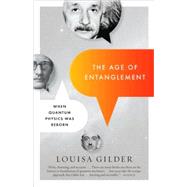
| List of Illustrations | p. xi |
| A Note to the Reader | p. xiii |
| Introduction: Entanglement | p. 3 |
| The Socks 1978 and 1981 | p. 8 |
| The Arguments 1909-1935 | |
| Quantized Light September 1909-June 1913 | p. 25 |
| The Quantized Atom November 1913 | p. 32 |
| The Unpicturable Quantum World Summer 1921 | p. 40 |
| On the Streetcar Summer 1923 | p. 49 |
| Light Waves and Matter Waves November 1923-December 1924 | p. 60 |
| Pauli and Heisenberg at the Movies January 8, 1925 | p. 68 |
| Heisenberg in Helgoland June 1925 | p. 74 |
| Schrödinger in Arosa Christmas and New Year's Day 1925-1926 | p. 82 |
| What You Can Observe April 28 and Summer 1926 | p. 86 |
| This Damned Quantum Jumping October 1926 | p. 94 |
| Uncertainty Winter 1926-1927 | p. 101 |
| Solvay 1927 | p. 110 |
| The Spinning World 1927-1929 | p. 115 |
| Solvay 1930 | p. 123 |
| Interlude: Things Fall Apart 1931-1933 | p. 128 |
| The Quantum-Mechanical Description of Reality 1934-1935 | p. 150 |
| The Search and the Indictment 1940-1952 | |
| Princeton April-June 10, 1949 | p. 181 |
| Berkeley 1941-1945 | p. 185 |
| Quantum Theory at Princeton 1946-1948 | p. 192 |
| Princeton June 15-December 1949 | p. 197 |
| Quantum Theory 1951 | p. 199 |
| Hidden Variables and Hiding Out 1951-1952 | p. 202 |
| Brazil 1952 | p. 208 |
| Letters from the World 1952 | p. 215 |
| Standing Up to Oppenheimer 1952-1957 | p. 221 |
| Letters from Einstein 1952-1954 | p. 223 |
| Epilogue to the Story of Bohm 1954 | p. 227 |
| The Discovery 1952-1979 | |
| Things Change 1952 | p. 233 |
| What Is Proved by Impossibility Proofs 1963-1964 | p. 237 |
| A Little Imagination 1969 | p. 250 |
| Nothing Simple About Experimental Physics 1971-1975 | p. 269 |
| In Which the Settings Are Changed 1975-1982 | p. 282 |
| Entanglement Comes of Age 1981-2005 | |
| Schrödinger's Centennial 1987 | p. 293 |
| Counting to Three 1985-1988 | p. 297 |
| "Against 'Measurement'" 1989-1990 | p. 303 |
| Are You Telling Me This Could Be Practical? 1989-1991 | p. 312 |
| The Turn of the Millennium 1997-2002 | p. 316 |
| A Mystery, Perhaps 1981-2006 | p. 325 |
| Epilogue: Back in Vienna 2005 | p. 331 |
| Glossary | p. 337 |
| Longer Summaries | p. 347 |
| Notes | p. 351 |
| Bibliography | p. 409 |
| Acknowledgments | p. 417 |
| Index | p. 419 |
| Table of Contents provided by Ingram. All Rights Reserved. |
The New copy of this book will include any supplemental materials advertised. Please check the title of the book to determine if it should include any access cards, study guides, lab manuals, CDs, etc.
The Used, Rental and eBook copies of this book are not guaranteed to include any supplemental materials. Typically, only the book itself is included. This is true even if the title states it includes any access cards, study guides, lab manuals, CDs, etc.
Excerpted from The Age of Entanglement: When Quantum Physics Was Reborn by Louisa Gilder
All rights reserved by the original copyright owners. Excerpts are provided for display purposes only and may not be reproduced, reprinted or distributed without the written permission of the publisher.